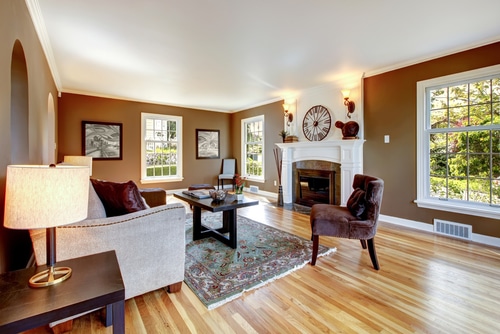
There are so many things to think about when you are ready to install hardwood flooring in your home. Selecting the wood species is the exciting part, and it will make the biggest impact on the look and feel of the space. Are you a traditional red oak type of person, or is modern maple more your thing? Beyond the aesthetics, however, determining the correct hardwood materials to use in your Grapevine home will be the biggest factor in how well the floors hold up over time.
Deciding between solid and engineered hardwood is one of the choices you will face when selecting new flooring. Once installed, the two are practically indistinguishable, but they are very different materials. Asking yourself some important questions will help you decide if solid or engineered flooring is the right choice for you. Where will the flooring be installed? How much moisture and humidity will it be exposed to? What is the subfloor made from? What is the budget for the project?
Following are some facts about solid and engineered hardwood flooring to help you understand the pros and cons of each.
Solid Hardwood Flooring
Solid hardwood flooring is just like it sounds. The planks are milled from a single piece of hardwood and are typically about three-quarters of an inch thick. Solid hardwood flooring can be sanded and re-stained again and again. Solid hardwoods should only be installed above grade and over a plywood subfloor. The planks will expand and contract with changes in humidity and are not recommended for rooms where moisture can accumulate, like the kitchen or bathroom.
Engineered Hardwood Flooring
Engineered hardwood flooring is constructed from several layers of plywood bonded together with a veneer of the preferred wood applied to the top. Whether or not the floors can be sanded and refinished in the future depends on the thickness of the veneer layer. Engineered hardwood can be installed over a concrete or plywood subfloor, and it won’t react as dramatically to moisture and humidity. It is preferred for installation below grade, such as the basement, and in bathrooms and kitchens.
Engineered flooring can be easier to install than solid hardwood and is typically less expensive, although the price and quality of the floor will really depend on the thickness of the veneer layer. Keep in mind that you get what you pay for when it comes to engineered hardwoods, and a lower priced material will not hold up as well over time.
Engineered hardwood is also a good option for families that are concerned about sustainability. Although solid hardwood that is harvested domestically is typically considered a sustainable resource, engineered hardwood uses less of the desired wood species, and you can find engineered flooring with sub layers that are constructed from recycled materials. If you are interested in an exotic hardwood species, an engineered version may be the way to go for environmental and financial reasons.
There is a lot to think about when selecting hardwood floors. When you do your research and select the best materials for your Grapevine home, you’re sure to find beautiful flooring that will stand the test of time.
Photo by Iriana Shiyan

